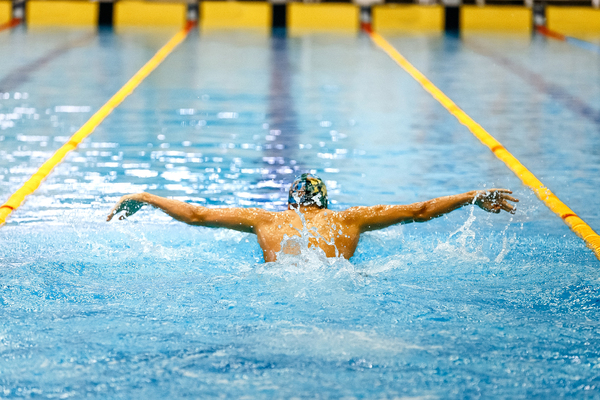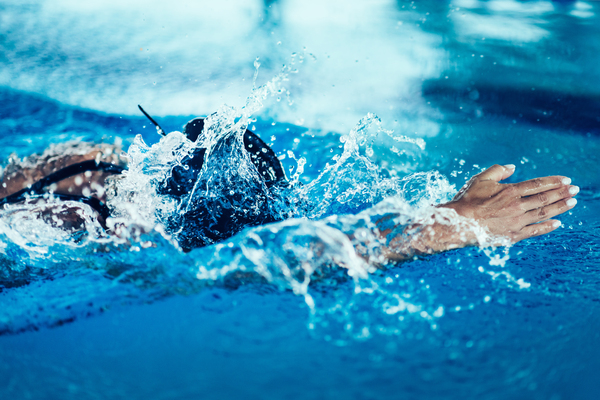Relay Swimming

The swimming relay is the primary competition held during the Olympic games and world championships. It is a battle in which four athletes compete as a team to cover the distance faster in total time. In each of the four-stage, swimmers must use different strokes: backstroke, butterfly, breaststroke, and freestyle, respectively.
Athletes have three race rules: 4 x 100m and 4 x 200m freestyle, and 4 x 100m complex. Before the race, athletes need to line up behind the jumping platform. The individual passage of the stage begins at the start signal, then the first diver after him, the remaining three players, enters the water. When the previous swimmer touches the wall, the rest of the players can jump into the pool.
Team disqualification occurs if one of the athletes leaves the platform before the previous one touches the wall. They are allowed to dive in close to touchdown situations, provided the foot remains in contact with the platform.
Game Environment
The rules established by FINA have specified the parameters for the depth, length, and width of the pools used in matches. The depth of the pool in two meters. They can be fifty or twenty-five meters long. For long-distance races, fifty meters long are used.
World records cannot be compared in groups of different lengths because swimmers have more or less movement in a race, which is advantageous. The lanes are marked from scratch, and each row must be at least 2.5 meters wide.
They are usually equipped with appetizer blocks at both ends of the pool. Following the FINA rules, automatic refereeing equipment with touch panels is needed to record the time. Earlier sensors were used to control absorption in the relay race.
Over the past few years, there has been a change in the block surface sloped towards the pool, and the start blocks have an elevated sloping platform at the end of the main one called a ledge. Taking a leaning position at a right angle and pushing off with the back foot allows the swimmer to take off with significant speed.
FINA
The International Olympic Committee (IOC) recognized the foundation for competition in water sports, which is the International Federation of Nations. It is based in Lausanne, Switzerland, and formulates the regulations not only for world wide records and tournaments but also organizes world competitions in aquatics.
FINA has over 200 member countries. This is a widespread sport, countries which take part in tournaments: USA, Australia, Canada, China, Korea, Tunisia, Great Britain, Japan, Russia, Austria, Romania, Norway, Hungary, Serbia, Ukraine, Trinidad and Tobago, Netherlands, Italy, Germany, and France.
Water Sport Variations
Intense swimming in a short distance is called a sprint. Sprinters concentrate on controlling their breathing and train exerting maximum effort while swimming. Swimmers are divided into sprinters in medium and long distances.
Usually compete in the 50m, 100m, and 200m races. Players are different in abilities and are practiced in different ways. The task of long-distance is to swim faster over long distances. It is in the interest to maintain a high average speed in competition because athletes have to withstand a large load for a long time.
The aim is to relax without losing pace during the long run. As a general rule, swimmers have more initial speed in medium distances and do not lose it as quickly as sprinters in long distances. The secret of good performance lies in the length of the cable, which is from 200 to 400 meters.

Swimming – How to play?
Competitive swimming has four main styles:
- Butterfly. Players need to keep their hands in a position parallel to their shoulders and dive into the pool. To raise the body, they rotate their arms in a semicircle. The body begins to move when the legs push the water, and the arms are in constant motion. The Butterfly style is observed as the most strenuous, as it originated from the breaststroke;
- Reverse move. In that variation, swimmers are kept on their backs and keep their heads above the water for the entire stroke and can breathe easily. Players cannot see their direction. During the fight, they know how many strokes they need to complete. In reducing resistance, one must kick the water with one’s fingers, and a semi-circular motion of the hand provides the necessary propulsion;
- Stroke. This variation has been known for many years. Stretching the arms of the athletes to the waist, they bring the knees closer to the hips while lowering the feet into the water. This grapple places a greater angle of the player’s body toward the surface of the water in an attempt to push off the water and resulting in drag and slow down. Swimmers deal with the impact by taking less emphasis at the start of the swim, shaping their body from head to hips as a mono more upright;
- Freestyle. There are few restrictions in freestyle racing. Swimmers alternately move their arms forward, pulling back the water. Of the four main styles, Front Crawl is the fastest. The game is not regulated, therefore it contains various front crawl options, such as the American and Australian crawl in races.
Each of these games has its own rules and history of creation. As you can see, water competitions are as significant as any other sport.
